What is an Arisaema?
Arisaema are members of the Aroid family (Araceae). It is a large genus of well over 200 herbaceous species. Their common name, Cobra Lilies, derives from the rather snake-like appearance of the inflorescence in some species. Although the Araceae are not all that well known in the UK, the family contains numerous popular ornamental plants including Arum, Arisarum and Zantedeschia.
Arisaema have a widespread distribution with the majority of species found in Asia, most notably parts of China, India, Malaysia and Japan. Some plants are also found from Eastern Africa and North America and Mexico. Many grow in temperate climates and make excellent garden plants for us in the UK, whilst others are strictly tropical in their requirements.
Those from temperate or sub-tropical habitats grow on a seasonal cycle from an underground tuber, usually starting into growth during the spring and entering a period of dormancy during the winter. Some tropical species also grow on a seasonal pattern, although because they don’t experience seasons in the same way, they are generally evergreen, growing from an underground rhizome.
Lets take a quick look at the various parts of an Arisaema:
Underground
As with any plant, the parts that exist below the soil are very important. This obviously includes the roots, but in the case of an Arisaema, also the tuber or rhizome. Although it may not look like it, this part is actually technically the stem, and from it will emerge the shoot which produces the leaves and inflorescence.
This tuber is the storage organ for the Arisaema, and it is contains much starchy material and food reserves. Species that grow on a seasonal cycle slough off the old tuber skin at the end of the season, and it is not uncommon to find these old remains underneath the tuber as a slimy gelatinous mass.
Most seasonal species produce offsets or bulblets around the parent tuber. A few make stolons with bulblets at the end. A guide to growing Arisaema from bulblets can be found on these cultivation pages.
The shape, size and colour of the tuber can vary widely between species. Unfortunately it is relatively common for nurseries to mis-sell species or give plants the wrong ID. It is not always possible to ID to exact species level just by looking at the tuber, but it’s possible to get close.
Above ground
The shoot that emerges from the tuber will go on to make the parts of the plant that are visible above ground. Whilst they may not look like a leaf, the first leaves are little more than thin sheathes that give support and protection to the developing shoot. These are termed cataphylls. In some cases they can produce a tall pseudostem.
The true leaves are held on a petiole and are divided into numerous leaflets, the number, size and shape of which will vary according to the species.
Finally, the spathe itself is a modified leaf bract. It is highly adapted and is funnel shaped with a lower spathe tube, mouth and spathe limb.
Flower
It is easy to think of an Arisaema flower as the often colourful spathe, but as has already been mentioned, this is in reality nothing more than a modified leaf. The spathe is held at the end of a peduncle. The image below shows a typical inflorescence for Arisaema amurense.

The flowers are actually located on the spadix and encased within the spathe tube. They are generally small and inconspicuous, and certainly not what many would consider a flower to look like. Plants may have either male flowers, female flowers, or both. The image below shows male flowers for Arisaema amurense. These can be seen shedding cream coloured pollen.
